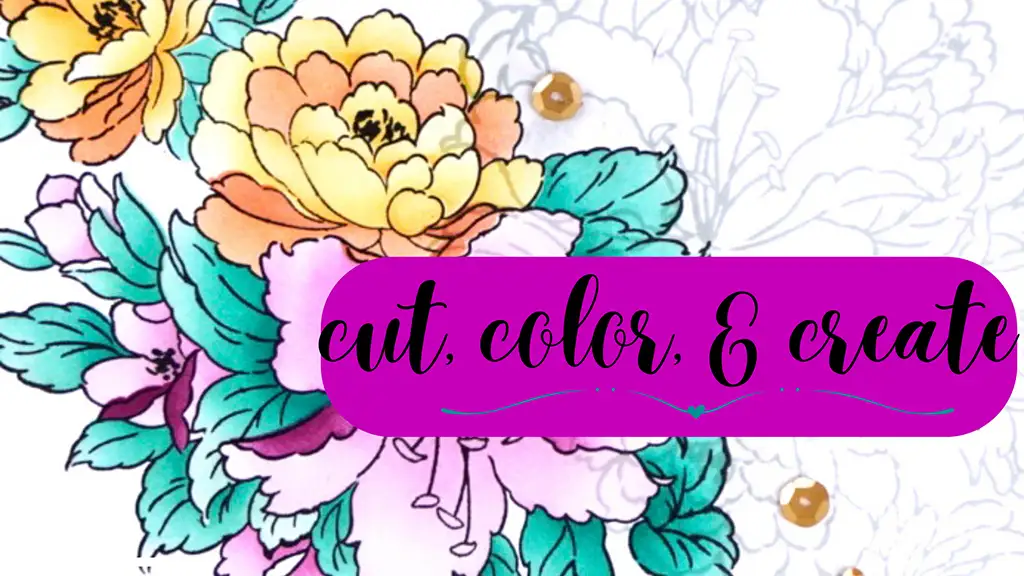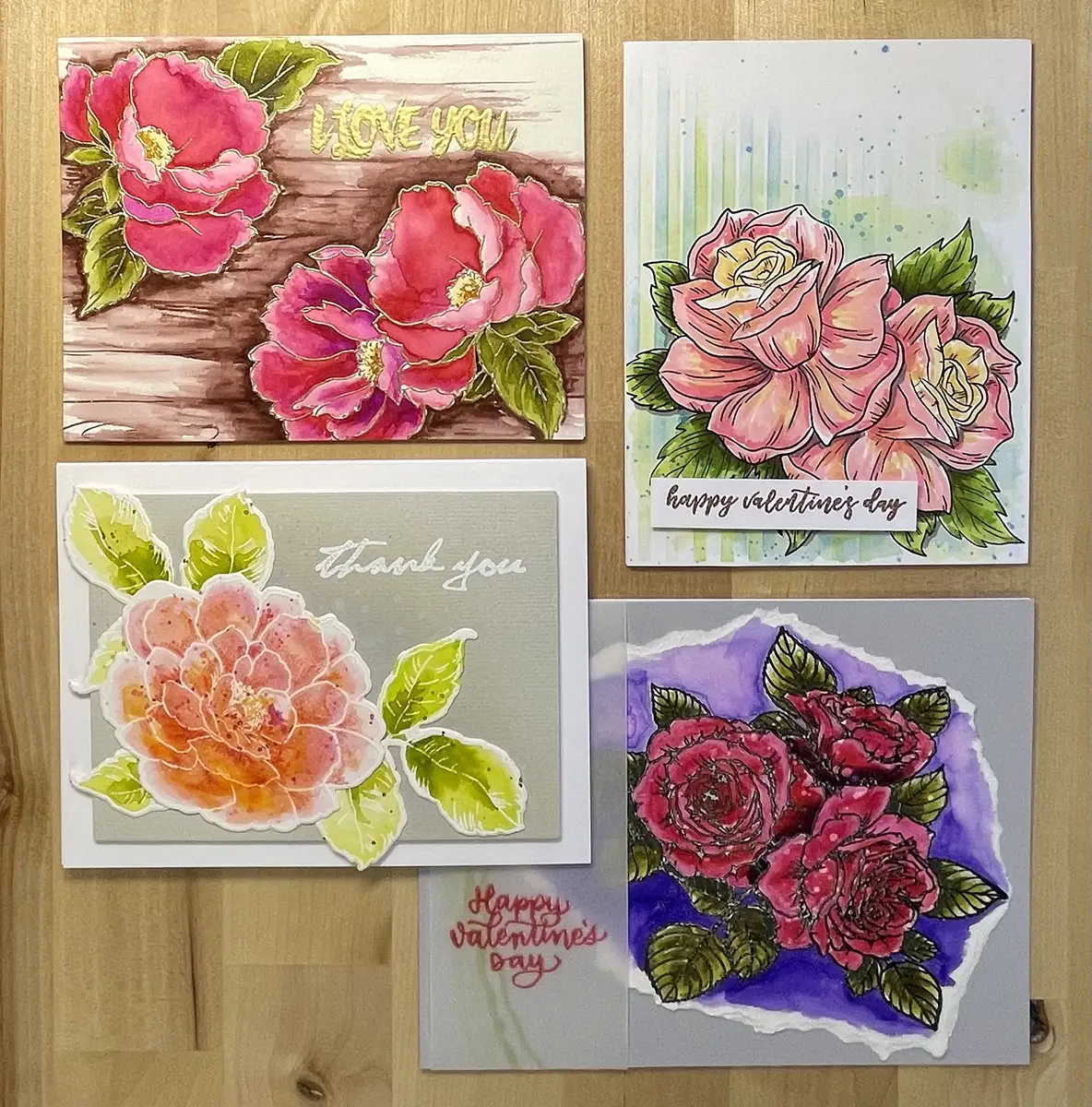You can make remarkable Valentine cards with our inspiring examples and tips.
We share them to help you create your own Valentines.
This is the last of five articles that are being written as part of Altenew's Educator Certification Program. This one shares tips and tricks associated with the cards created while taking Creative Coloring with Erum -Advanced Techniques Online Class.
I am not sharing the techniques that the instructor, Erum Tasneem, teaches in her class, but instead, I share hints and tips that I tried and learned while taking her class.
There are only six lessons in this class but Erum shares a plethora of wonderful techniques and examples within each. She is a fantastic instructor who helps take you to the next level in coloring. Her creativity is addictive and as you can see in these four examples the results are remarkable.
Links to the other four articles that I have written can be found later in this article.
Love Letter Remarkable Valentine
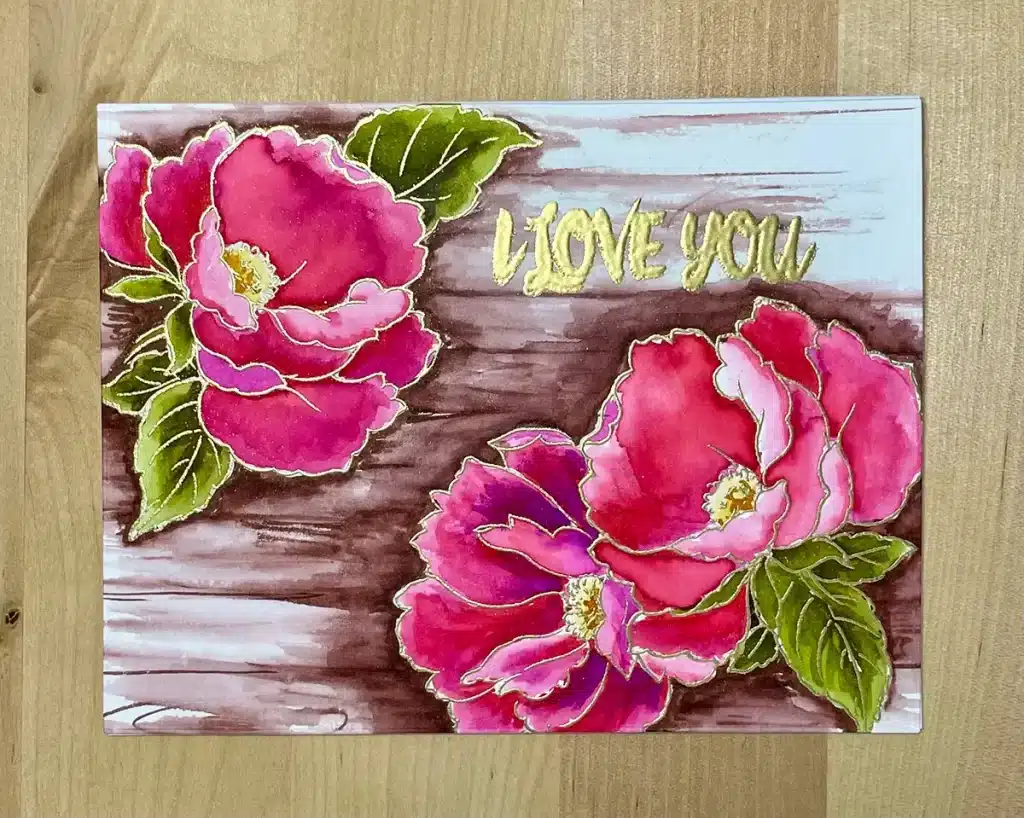

To make this card you'll need to choose a striking floral outline stamp. Stamp it onto a white watercolor A2 Sized card panel with watermark ink.
And, this mesmerizing card is created using loose watercolor painting techniques. The images are heat embossed after stamping using masking techniques. As a result, we'll end up with a more realistic image.
The gold heat-embossed images create an elegant feel for the card. But they have a second quality, they will resist watercolor paints. And that becomes beneficial in the next step as we color the images.
Coloring the Images for the Remarkable Valentine Love Letter
We're using the dry brush technique with watercolor brush markers for this step. I love these brush markers because their colors are so vibrant and beautiful. Keeping in mind where the shadows should be, we apply different colors directly to the card panel beginning with the darkest colors
Then using a watercolor brush, working one petal at a time, we'll release the colors with water and draw them towards the tips of the petals. Hint: the different colors we added to each petal in the last step mix beautifully on their own when water is added to them. Don't mix them too much or you risk having them blend too much.
Another Hint: After pulling the color out, carefully pull from the tip of the petal back toward the base with the watercolor brush. This will lighten up the tips making them look like they are sun-kissed.
We'll use the same techniques for the leaves and stems.
Adding Woodgrain Texture To The Background
This is where Erum really pushes me out of my comfort zone. I am so happy with my images that I'm afraid that I'll ruin them by adding a background. Hint: Take those challenges to push you to go somewhere you've never been before. You might just end up with something even better than what you had before… as I did!
We can always fussy cut the images out if we don't like what we do with the background, right? So let's keep going. We begin the background using the same technique as we used for the images. But this time we're using the color mostly around the flowers and leaves as shadows behind them.
Then, with our watercolor brush, and taking care not to disturb the shadows we just created we'll the color out. Our goal is to create the look of planks of wood. To do that we'll go back with the watercolor brush marker to add the tree rings and seams between the planks using water to soften the lines where needed.
Working in layers we just keep working with dry marker and water until we're happy with the background.
Finishing the Card
To finish the card we'll heat emboss the sentiment directly onto the card panel. We're using gold again to add additional elegance. And we'll add a sweet sentiment on the inside using black pigment ink.
And then all we have left to do is to attach the card panel to the card base with a dot adhesive runner.
Supplies
The following list may contain affiliate links. If you purchase something by following a link on this page, I may receive a small commission at no extra cost to you. Thank you for supporting my blog.
- Cardstock: Card base – Neenah Classic Crest 110lb Solar White; Card panel – Canson XL
- Stamp: Altenew Airbrushed Flowers; Altenew Oriental Orchid; Altenew Sentiment Strips
- Ink: Watermark Ink – Versamark; Pigment ink – Altenew Obsidian
- Watercolor Brush Markers: Altenew Ruby Red, Purple Wine, Rubellite, Midnight Violet, Yellow Ochre, Mango Smoothie, Sea Forest, Moss, Tree Bark; Altenew Watercolor Brush
- Embossing Powder: Altnew Antique Gold Crisp
- Adhesive: Gina K Designs Dot Adhesive Runner
Watercolor Brush Remarkable Valentine


To create this eye-catching card we use the same techniques and tools as we use for the first card. However, instead of creating a wood-textured background we just add the color and draw it out just like we do for the flowers. And we color the background at the bottom of the card slightly darker than we do at the top.
And we'll use a couple of unique methods to finish the card.
We're going to tear the edges around the image by hand taking advantage of the properties of the watercolor paper to create a frilly edge. By doing so, the size and shape of our images present a problem with how and where to place the sentiment.
We solve it by using vellum. The vellum allows us to add our beautiful sentiment without covering our lovely images and we can use it to add more design elements to the card with it.
We'll trim the vellum just slightly wider than the sentiment and longer than the card from top to bottom. We'll stamp our sentiment using ink that matches the watercolor brush markers that we used to color the flowers and then we heat emboss it with clear embossing powder to step it up a notch.
Hint: Vellum is more prone to warping than cardstock when using a heat tool. Therefore, use a lower setting if your heat tool has one. Or you can use a craft heat tool made for drying watercolors that uses a lower flat heat.
Assembly of the Watercolor Brushed Remarkable Valentine
To assemble the card we'll begin by attaching the images to the color layer with a glue runner. Then we'll put the vellum in the place where we want it and then fold the top and bottom edges around the color layer.
We'll use a glue runner to fasten the vellum to the backside of the color layer, taking care to keep the edge of the vellum parallel to the edge of the card. Then we'll use the glue runner again to attach the color panel to the card base.
Supplies
The following list may contain affiliate links. If you purchase something by following a link on this page, I may receive a small commission at no extra cost to you. Thank you for supporting my blog.
- Cardstock: Card base – Classic Crest 110lb Solar White; Card panel – Canson XL; Color layer – Lawn Fawn – Fog: Vellum – Gina K Designs
- Stamp: Picket Fence Rose Bouquet, Simon Says Stamp Handwritten Love
- Ink: Altenew Crisp Dye Ink Ruby Red; Pigment Ink Obsidian; Watermark Ink – Versamark
- Watercolor Brush Markers: Altenew Ultraviolet, Purple Wine, Ruby Red, Rubellite, Moss, Seaforest
- Embossing Powder: Altenew Crystal Clear
- Craft Heat Tool: Ranger Craft Tool
- Adhesive: Gina K Designs Dot Adhesive Runner
One Layer Watercolor Remarkable Valentine
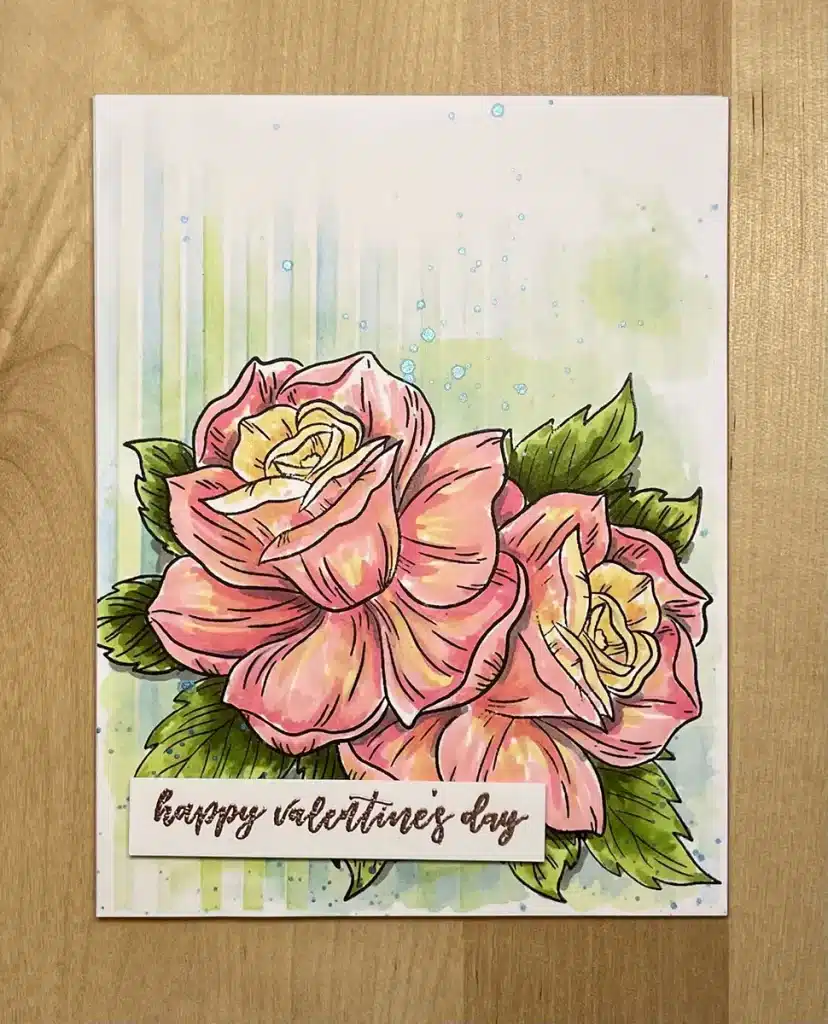
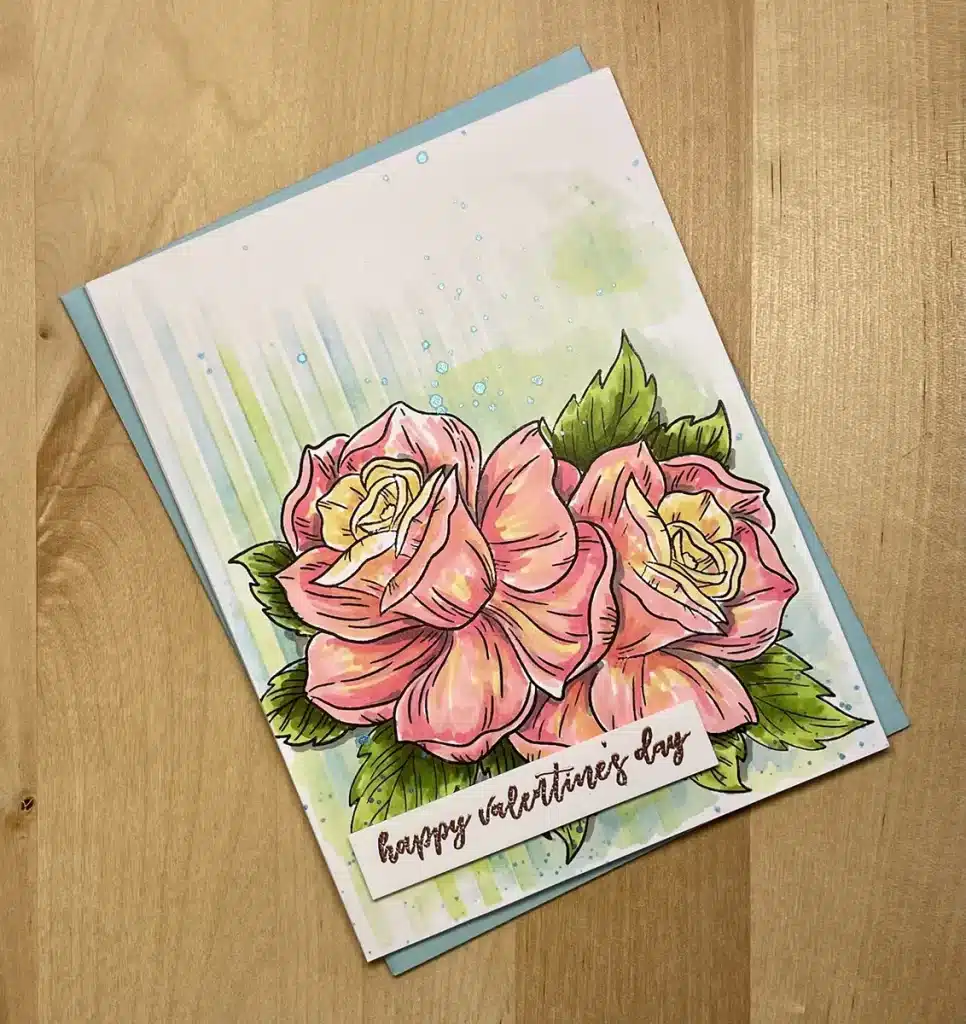
The coloring for this whimsical one-layer card is done with alcohol markers. We'll stamp our images with black multi-media ink, masking them as we go. Using the Peace Rose for inspiration we'll color our flowers and leaves.
Hint: Using shadows makes the difference between images that have dimension and one that is flat. With markers, we can add them by using a darker tone of the color we are using and we can use gray tones.
We'll add a loose watercolor background to add further dimension. Then we'll mask off our images, blend over a stencil, and then splatter with metallic watercolors to add more interest to the card.
Finally, we'll top it off by adding a lovely heat-embossed sentiment.
Supplies
The following list may contain affiliate links. If you purchase something by following a link on this page, I may receive a small commission at no extra cost to you. Thank you for supporting my blog.
- Cardstock: Card base – Neenah Classic Crest 110lb Solar White; Card panel – Neenah Classic Crest 80lb Solar White
- Stamps: Altenew Darling Rose, Altenew Love Letters
- Stencil: Altenew Classy Stripes
- Inks: Altenew Crisp Dye Inks – Bamboo, Dusk, Sea Glass; Multi-media – Gina K Designs Amalgam Ink Obsidian; Watermark – Versamark
- Alcohol Markers: Altenew – Frosty Pink, Coral Berry, Ruby Red, Buttercream, Frayed Leaf, Forest Glades, Moss, Silver Stone, Limestone
- Embossing Powder: Altenew Copper Crisp
- Watercolor Paints: Altenew Metallic; Altenew 24 pan set
Splatter Watercolor


Ok, this technically isn't a Valentine, but it could be by switching out the sentiment. And, we may just need a thank you card for the Valentine we receive…you never know!
Like the other cards in this article, we use heat embossing to create the outlines of our lovely images. The beautiful coloring comes from spattering watercolor paint in a couple of different ways. Firstly, we'll splatter images that are wet to create beautiful random coloring that can be somewhat controlled by the direction the splatters are made.
The wet splatter technique results in a beautiful mix of colors. To learn how to do it, please attend the class.
To step up our design, we'll splatter more of the same colors once the first step has dried. And, we conduct both steps for the leaves as well as for the flower.
Once all the coloring of the images is complete we'll cut them out using the coordinating dies. Hint: Cutting apart the leaves gives us more ways we can arrange them behind the flowers.
Background and Assembly
At this point, the images are quite pale, even though the photography doesn't necessarily represent them as so. To help draw attention to them we'll do some blending on some textured cardstock. And then we will create more splatters, this time using metallic watercolor paints. We do this to add some pizzazz to the card.
Before doing so we'll arrange the images on the color panel so that we can determine where to position the blending and add the sentiment. Hint: Using Glad Press-N-Seal to keep the arrangement in place helps with step and when we glue it onto the card panel.
Now we will heat emboss the sentiment directly on the background. Hint: A handy way to flatten warping that results from heat embossing is to run the warped panel through a die-cutting machine.
To finish the card we'll trim the colored background card panel using a die to ensure that the cuts are square. We'll center it on the card base and attach it with a glue runner. As a result, the card base peeks out and frames the card in white.
Supplies
The following list may contain affiliate links. If you purchase something by following a link on this page, I may receive a small commission at no extra cost to you. Thank you for supporting my blog.
- Cardstock: Card base – Neenah Classic Crest 110lb Solar White; Images – Canson XL, Color layer – Lawn Fawn Fog
- Stamp: Altenew Beautiful Heart; Altenew Many Thanks
- Die: Altenew Beautiful Heart; Gina K Designs Master Layouts 2
- Watercolor Paints: Altenew 36 pan, Altenew 24 pan, Altenew Metallic
- Ink: Distress Oxide Pumice Stone
- Embossing Powder: Altenew Pure White Crisp
- Adhesives; Gina K Designs Dot Adhesive Runner; Barely Art Glue
Related Articles
The other third level classes I have taken coupled with the articles I have written after taking them:
- Botanical Illustration Inspired Watercolor Advanced Watercolor Techniques Online Class – Interested in Learning How to Watercolor?
- Progressive Cardmaking – How To Create 3 Fantastic Floral Greeting Cards.
- Stencils unleashed; Advanced Stencil Techniques – How to Create Optical illusions With Graphite.
- Transcending Tattoo Techniques – How to Make Cards using Tattoo for inspiration
To date, I have taken twenty-five Altenew Online classes as part of the AECP program; ten first level, ten second level, and four of the third level. Even though I have been crafting for a very long time, I have learned more than you can imagine!
You can see the improvements that I've made in the quality of my work by viewing my early posts.
